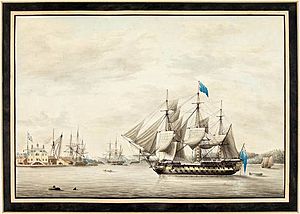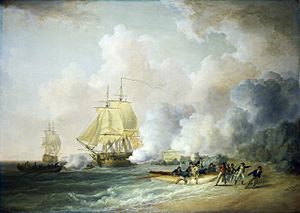HMS Asia (1764) facts for kids

HMS Asia at the Halifax Naval Yard, 1797. Watercolour by George Gustavus Lennox, who was a lieutenant aboard Asia
|
|
Quick facts for kids History |
|
|---|---|
| Name | HMS Asia |
| Ordered | 20 March 1758 |
| Builder | Edward Allin & Thomas Bucknall, Portsmouth Dockyard |
| Laid down | 18 April 1758 |
| Launched | 3 March 1764 |
| Commissioned | March 1771 |
| Decommissioned | March 1802 |
| In service |
|
| Fate | Broken up, 1804 |
| General characteristics | |
| Class and type | 64-gun third-rate ship of the line |
| Tons burthen | 136446⁄94 (bm) |
| Length | 158 ft 0 in (48.2 m) (gundeck) |
| Beam | 44 ft 6 in (13.6 m) |
| Draught |
|
| Depth of hold | 18 ft 10 in (5.7 m) |
| Propulsion | Sails |
| Sail plan | Full-rigged ship |
| Armament |
|
HMS Asia was a 64-gun third-rate ship of the line of the Royal Navy. She was built by Thomas Bucknall and launched on March 3, 1764, at Portsmouth Dockyard. This powerful warship took part in the American Revolutionary War and helped capture Martinique in 1794. She was taken apart for scrap in 1804.
Contents
Ship Design and Importance
Sir Thomas Slade created the design for HMS Asia. This design was very new and important because Asia was the first true 64-gun ship. Before her, the Royal Navy built 60-gun ships.
Because Asia's design was so successful, the Navy decided to build more 64-gun ships instead of 60-gun ones. Later 64-gun ships were made a bit bigger after lessons learned from Asia. This means Asia was unique and the only ship of her exact design.
Service History of HMS Asia
Early Years in the American Revolution
HMS Asia began her service during the American Revolutionary War. In 1774, she carried 500 Royal Marines to New York City. Their job was to help calm down growing problems among the people there.
She arrived in New York Harbor on December 4 and stayed for a few weeks. Later, she joined a group of ships led by Admiral Richard Howe. By January 1, 1775, she was part of Vice Admiral Graves' North American Squadron, under Captain Geo Vanderput.
Protecting the Governor
Asia returned to New York Harbor and protected a merchant ship called Duchess of Gordon. The Royal governor, William Tryon, used this ship as his temporary office. He was worried about being arrested by the American rebels if he stayed on land.
On board Asia, Governor Tryon and Loyalist Mayor David Mathews planned a way to harm George Washington. A soldier named Thomas Hickey, who was part of Washington's special guard, was later executed for being involved in this plot.
Surviving a Fire Attack
In August 1776, Asia was at the Battle of Brooklyn. She survived an attack by an American revolutionary named Silas Talbot. He used a fire ship, which is a ship set on fire and sent to burn enemy vessels.
The fire ship hit Asia and set her on fire. But the crew, with help from other ships nearby, quickly put out the flames. Later, in 1778-1779, Asia helped escort merchant ships, called East Indiamen, to India.
French Revolutionary Wars Service
Asia was put back into service in May 1793, under Captain John Brown. On December 26, he sailed her to the West Indies to join Admiral Sir John Jervis.
In March 1794, Asia helped capture Martinique. This was done by a British force led by Admiral Jervis and Lieutenant General Sir Charles Grey. By March 16, the British had taken almost all the forts.
On March 20, Asia and Zebra were supposed to sail into Fort Royal to attack Fort Saint Louis. However, Asia's pilot refused to take her in, saying he feared shallow waters. So, Zebra went in alone. Her brave captain, Richard Faulknor, and his crew landed under the fort's guns and captured it.
Asia returned to England in July 1794. The next month, Captain John M'Dougall took command, and she joined the Downs squadron.
Fire Incident in Jamaica
On April 29, 1796, Asia faced another fire, this time in Port Royal, Jamaica. This fire started when some gunpowder barrels on the lower deck exploded. About 300 of the crew jumped overboard, fearing the main gunpowder storage would explode too.
However, Asia's captain, officers, and a few remaining crew members managed to put out the fire. In total, 11 men were killed or wounded during this incident.
From 1796, Captain Robert Murray commanded Asia. In 1800, she sailed to Halifax. There, she picked up about 600 Jamaican Maroons. These people had been sent away from Jamaica the year before and were now being moved to Sierra Leone. Asia left Halifax on August 8 and arrived in Sierra Leone on September 30, where the Maroons disembarked.
Final Years and Fate
HMS Asia was taken out of service in March 1802. She was broken up, meaning taken apart for materials, in August 1804 at Chatham Dockyard.


